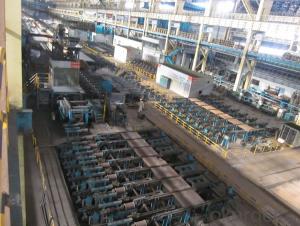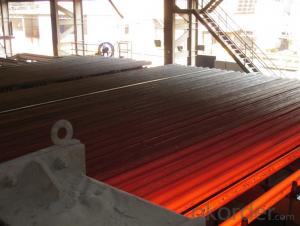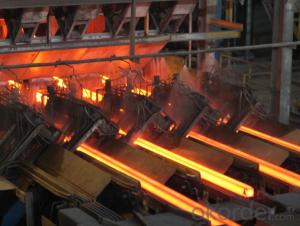Square Steel Billet Q235 Grade Prime Quality 1#
- Loading Port:
- Tianjin
- Payment Terms:
- TT OR LC
- Min Order Qty:
- 2000 m.t
- Supply Capability:
- 50000 m.t/month
OKorder Service Pledge
OKorder Financial Service
You Might Also Like
Description of Square Steel Billet Q235 Grade Prime Quality 1#
M. S. Billets are used for rolling of TMT Re-Bars of Fe415 and Fe500 Grade and various other structural steel products.
CRS Billets are used for rolling of CRS TMT Re-Bars.
Special Alloy Billets are used for rolling of any special grade TMT Re-Bars like Earthquake resistant TMT Re-Bars and for special grade structural steel products.
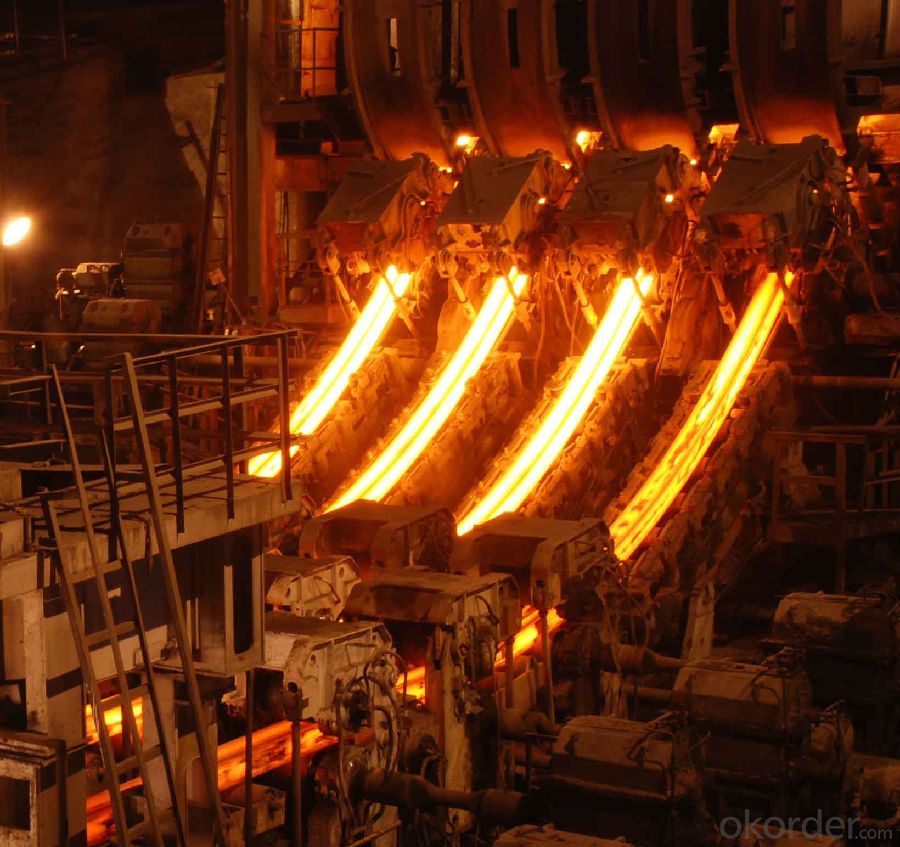
Main Feature Square Steel Billet Q235 Grade Prime Quality 1#
Raw elements(C,Fe,Ni,Mn,Cr,Cu.)---Smelted ingots by AOD finery---hot rolled into black suface---pickling in acid liquid---cold drawn----polished by automatically machine--- cutting into pieces---checking quanlity
Applications of Square Steel Billet Q235 Grade Prime Quality 1#
Widely Used in the areas such as Stainless Steel Fasteners, Chains, Kitchen and Sanitary wares, Furniture handles, Handrails, Electroplating and Electrolyzing pendants, Foods, Electron, Petroleum, Construction and Decoration, etc. Products have a high strength after cold-working. Electronic products parts, Medical appliance, Springs, Bus Inside and Outside packaging and building, Street Lamp Posts, etc. Decoration materials and Outdoor Publicity Billboard. Used for the products which have the Anti-Stress Corrosion requirement. Electron Products, Table-wares, Bolts, Nuts, Screen Meshes, Cumbustors and so on.
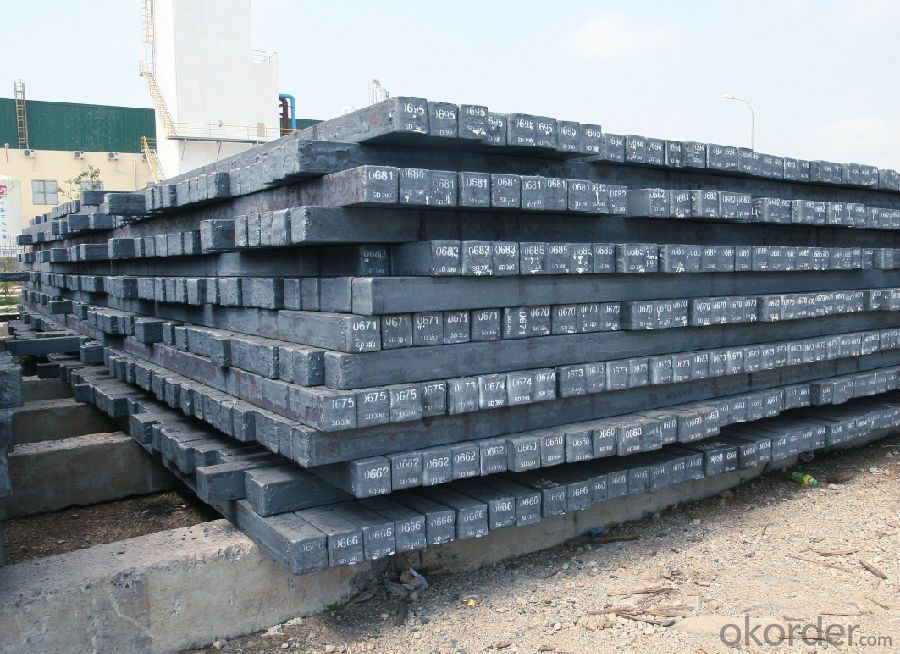
Specifications of Square Steel Billet Q235 Grade Prime Quality 1#
| Standard | C(%) | Mn(%) | S(%) | P(%) | Si(%) |
| Q195 | ≤0.12 | ≤0.50 | ≤0.040 | ≤0.035 | ≤0.30 |
| Q235 | ≤0.20 | ≤1.40 | ≤0.045 | ≤0.045 | ≤0.35 |
| Q275 | ≤0.22 | ≤1.50 | ≤0.045 | ≤0.045 | ≤0.35 |
| 20MnSi | 0.17-0.25 | 1.2-1.6 | ≤ 0.050 | ≤ 0.050 | 0.40-0.80 |
| 3SP | 0.14-0.22 | 0.40-0.85 | ≤ 0.050 | ≤ 0.040 | 0.05-0.15 |
| 5SP | 0.28-0.37 | 0.50-1.00 | ≤ 0.050 | ≤ 0.040 | 0.15-0.30 |
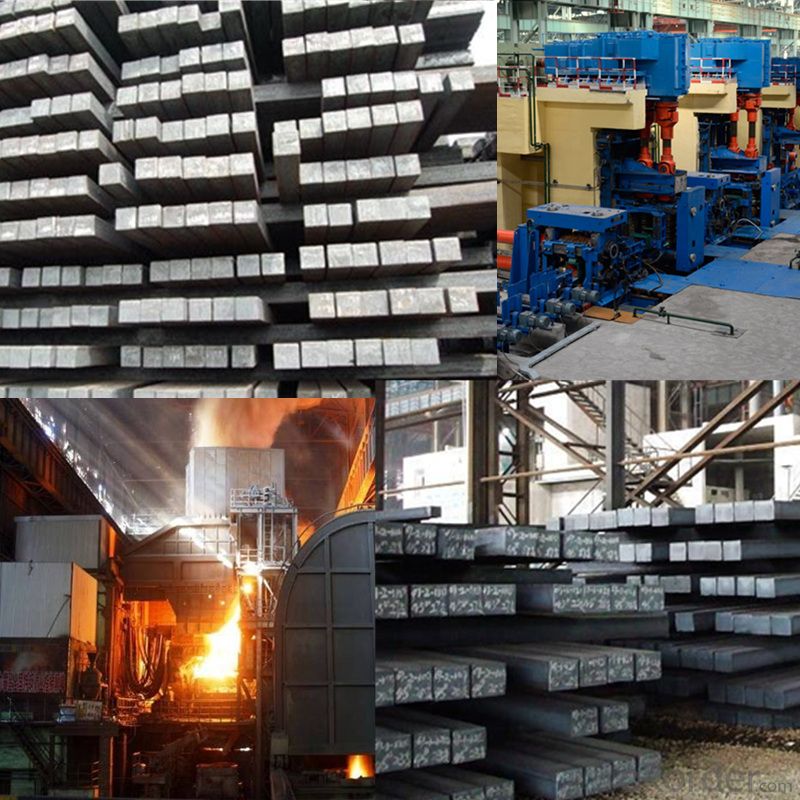
FAQ of Square Steel Billet Q235 Grade Prime Quality 1#
We have organized several common questions for our clients,may help you sincerely:
1. How Can I Visit There?
Our company is located in Tianjin City, China, near Beijing. You can fly to Tianjin Airport Directly. All our clients, from home or aboard, are warmly welcome to visit us!
2. How Can I Get Some Sample?
We are honored to offer you sample.
3. Why choose CNBM?
Our delivery time about 15-20days for standard sizes, if you have other requirements like hardness, quanity and width ,it is about 20-40days. But don't worry we also try our best for the delivery time ,because time longer and our cost is higher.
- Q:How are steel billets used in the manufacturing of gears?
- Steel billets are used in the manufacturing of gears as the raw material for forging or machining processes. They are typically heated and shaped into the desired gear shape, either through hot forging or by cutting and grinding. The steel billets provide the strength and durability required for gears to withstand the heavy loads and high stresses they experience during operation.
- Q:How do steel billets contribute to the manufacturing of industrial equipment?
- Steel billets are a crucial component in the manufacturing of industrial equipment. These billets, which are semi-finished steel products, are produced through a casting process and serve as the raw material for various industrial equipment. One of the primary ways steel billets contribute to the manufacturing of industrial equipment is through their versatility. Due to their malleability and strength, steel billets can be easily shaped and molded into different forms, such as bars, rods, or sheets, depending on the specific requirements of the equipment being produced. This allows manufacturers to create components and structures that are durable, reliable, and capable of withstanding heavy loads and extreme conditions. Furthermore, steel billets offer excellent strength-to-weight ratio, making them ideal for applications where weight reduction is necessary without compromising structural integrity. Industrial equipment often needs to be transported or moved around, and the use of lightweight steel billets helps in optimizing efficiency and minimizing energy consumption. Moreover, steel billets contribute to the manufacturing of industrial equipment by providing excellent resistance to corrosion and wear. Many industrial environments, such as mining, construction, or marine operations, expose the equipment to harsh conditions, including exposure to moisture, chemicals, and abrasion. The use of steel billets ensures that the equipment can withstand these challenges and maintain its performance over time, reducing maintenance and replacement costs. Additionally, steel billets enable efficient heat treatment processes during the manufacturing of industrial equipment. By subjecting the billets to controlled heating and cooling procedures, manufacturers can enhance the mechanical properties, such as hardness, toughness, and ductility, of the steel. This allows for the production of equipment that can withstand high temperatures, extreme pressures, and dynamic loading conditions, ensuring safety and reliability in various industrial applications. In conclusion, steel billets play a crucial role in the manufacturing of industrial equipment by providing versatility, strength-to-weight ratio, corrosion resistance, and facilitating heat treatment processes. Their contribution ensures the creation of durable, reliable, and high-performance equipment that can withstand the demands of various industries.
- Q:How are steel billets used in the production of mining conveyors?
- Steel billets are used in the production of mining conveyors as they serve as the raw material for manufacturing various components such as frames, supports, and conveyor belts. These billets are heated, shaped, and machined to create the required parts that are strong, durable, and capable of withstanding the harsh conditions of the mining environment.
- Q:What are the main challenges in the transportation of steel billets?
- The main challenges in the transportation of steel billets include ensuring proper handling and securing of the heavy and bulky loads, preventing damage or deformation during loading and unloading processes, and complying with safety regulations for transporting hazardous materials. Additionally, factors such as limited availability of specialized equipment, fluctuations in fuel prices, and coordinating logistics for long-distance shipments can pose challenges for efficient and cost-effective transportation of steel billets.
- Q:What are the different surface treatments for corrosion resistance in steel billets?
- There are several surface treatments available for enhancing corrosion resistance in steel billets. These treatments are crucial in preventing the formation of rust and oxidation, which can significantly deteriorate the quality and lifespan of the steel billets. Some of the commonly used surface treatments for corrosion resistance in steel billets include: 1. Hot-dip galvanizing: This process involves immersing the steel billets in a bath of molten zinc, forming a protective coating on the surface. The zinc coating acts as a sacrificial layer, shielding the steel from corrosion. 2. Electroplating: This method involves depositing a thin layer of a corrosion-resistant metal, such as nickel or chromium, onto the steel billet's surface using an electrochemical process. The plated metal acts as a barrier, preventing direct contact between the steel and corrosive agents. 3. Passivation: This treatment involves treating the steel surface with chemicals, typically an acid solution, to remove any impurities or contaminants that may promote corrosion. Passivation creates a passive oxide layer on the surface, which provides corrosion resistance. 4. Powder coating: In this process, a dry powder is applied to the steel billet's surface electrostatically and then cured under heat. The powder melts and forms a protective layer on the steel, which offers excellent corrosion resistance. 5. Organic coatings: These coatings, such as paints or varnishes, are applied to the steel billet's surface. They provide a protective barrier against moisture and corrosive agents. Organic coatings can be customized to meet specific requirements in terms of color, texture, and durability. 6. Anodizing: This treatment is typically used for aluminum or aluminum alloy steel billets. It involves creating an oxide layer on the surface by subjecting it to an electrochemical process. The resulting anodized layer enhances corrosion resistance and also provides an aesthetic appearance. It is important to choose the appropriate surface treatment based on the specific requirements of the steel billets, considering factors such as the intended application, environmental conditions, and expected lifespan. Regular maintenance and periodic reapplication of the surface treatment may also be necessary to ensure continued corrosion resistance.
- Q:What are the challenges faced by the steel billet industry?
- The steel billet industry encounters numerous obstacles that affect its operations and profitability. One notable challenge is the ever-changing global demand for steel products. Economic cycles exert a significant influence on the industry, directly impacting the demand for steel billets. When the economy experiences a downturn or slower growth, the demand for steel products decreases, resulting in excess inventory and reduced prices. Consequently, steel billet manufacturers face lower profit margins and struggle to sustain their operations. Additionally, the industry confronts fierce competition from other steel producers, particularly those in emerging markets. Countries like China and India have considerably expanded their steel production capacities in recent years, leading to a surplus in the global market. This oversupply drives down prices, making it arduous for steel billet manufacturers to compete on cost and maintain profitability. Moreover, the availability and pricing of raw materials pose another significant challenge for the industry. The production of steel billets necessitates a consistent supply of iron ore and other raw materials, which are susceptible to price fluctuations and disruptions in the supply chain. Any interruptions or fluctuations in the availability or cost of these raw materials can adversely affect the overall cost structure and profitability of the steel billet industry. Furthermore, environmental regulations and concerns about sustainability present an additional hurdle for the steel billet industry. Steel manufacturing is a resource-intensive process that generates substantial emissions and waste. As governments and consumers become more conscientious about environmental issues, steel billet manufacturers must invest in cleaner technologies and comply with stricter regulations. These investments can be costly and impact the industry's profitability and competitiveness. Lastly, the industry grapples with the challenge of technological advancements and innovation. To enhance production processes, improve product quality, and meet evolving customer demands, steel billet manufacturers must consistently invest in research and development. Staying abreast of the latest technological advancements necessitates significant investment, which can be particularly challenging for smaller players in the industry. In conclusion, the steel billet industry confronts various challenges, including fluctuating global demand, intense competition, raw material availability and pricing, environmental regulations, and technological advancements. Adapting to these challenges requires strategic planning, continuous improvement, and investment in innovation to remain competitive and sustainable in the market.
- Q:What is the typical density of a steel billet?
- The density of a steel billet is contingent upon the particular type of steel employed. Nonetheless, in broad terms, the range of density for a steel billet falls between 7.75 and 8.05 grams per cubic centimeter (g/cm³). This density may exhibit slight fluctuations due to the steel's composition and quality. It is crucial to acknowledge that the presence of any impurities or contaminants in the material may additionally impact the density of a steel billet.
- Q:Are steel billets used in the manufacturing of industrial machinery?
- Commonly used in the manufacturing of industrial machinery are steel billets. These semi-finished products are typically produced through continuous casting. They serve as the raw material for various types of machinery, including heavy-duty equipment, construction machinery, and machine tools. Industrial machinery prefers steel due to its strength, durability, and resistance to wear and tear. Steel billets often serve as the starting material for processes such as forging, rolling, or machining to create specific components required for machinery. These components encompass gears, shafts, frames, brackets, and other structural parts. Steel possesses high-quality properties, including high tensile strength and excellent mechanical properties, making it an ideal material for enduring demanding conditions and heavy loads in industrial machinery. Furthermore, steel's easy weldability and machinability allow manufacturers to produce intricate and precise parts for machinery. In summary, steel billets play a vital role in the manufacturing of industrial machinery. They provide the necessary raw material to create robust and dependable components capable of withstanding the challenges posed by various industrial applications.
- Q:What are the different types of steel billet forging defects?
- There are several different types of steel billet forging defects that can occur during the forging process. These defects can have various causes and can impact the quality and integrity of the final forged product. Some of the common types of defects include: 1. Surface cracks: These are cracks that occur on the surface of the billet. They can be caused by excessive heating or cooling, improper forging techniques, or the presence of impurities in the steel. 2. Internal voids: These are cavities or voids that form within the billet. They can be caused by incomplete filling of the mold, improper venting, or the presence of gases trapped within the steel. 3. Inclusions: These are foreign materials or impurities that are present within the billet. They can include non-metallic particles, such as oxides or sulfides, or metallic impurities, such as slag. Inclusions can weaken the structure of the steel and reduce its overall quality. 4. Segregation: This refers to the non-uniform distribution of alloying elements within the billet. It can occur during the cooling process and can result in areas of the steel with different mechanical properties. This can lead to inconsistencies in the final product. 5. Dimensional inaccuracies: These defects refer to deviations from the desired shape or size of the billet. They can be caused by improper tooling or die design, inadequate heating or cooling processes, or improper handling during forging. 6. Grain structure abnormalities: The grain structure of the steel can be affected by various factors, such as improper heating or cooling rates. Abnormal grain structures can weaken the steel and reduce its mechanical properties. It is important to identify and address these defects during the production process to ensure the quality and reliability of the final forged product. Quality control measures, such as non-destructive testing and visual inspections, can help to detect and rectify these defects before the finished product is delivered to the customer.
- Q:What are the weight ranges of steel billets?
- The weight ranges of steel billets can vary depending on the specific requirements and industry standards. However, commonly used weight ranges for steel billets are typically between 1,000 kilograms (2,204 pounds) to 5,000 kilograms (11,023 pounds).
1. Manufacturer Overview |
|
|---|---|
| Location | |
| Year Established | |
| Annual Output Value | |
| Main Markets | |
| Company Certifications | |
2. Manufacturer Certificates |
|
|---|---|
| a) Certification Name | |
| Range | |
| Reference | |
| Validity Period | |
3. Manufacturer Capability |
|
|---|---|
| a)Trade Capacity | |
| Nearest Port | |
| Export Percentage | |
| No.of Employees in Trade Department | |
| Language Spoken: | |
| b)Factory Information | |
| Factory Size: | |
| No. of Production Lines | |
| Contract Manufacturing | |
| Product Price Range | |
Send your message to us
Square Steel Billet Q235 Grade Prime Quality 1#
- Loading Port:
- Tianjin
- Payment Terms:
- TT OR LC
- Min Order Qty:
- 2000 m.t
- Supply Capability:
- 50000 m.t/month
OKorder Service Pledge
OKorder Financial Service
Similar products
New products
Hot products
Related keywords
